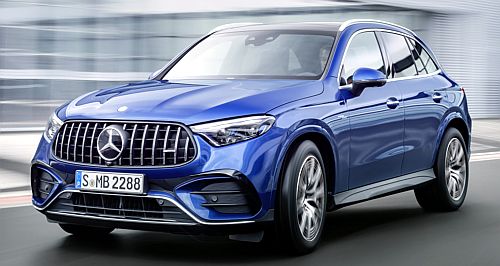News - Market Insight - Market Insight 2023Market Insight: Premium Germans on the levelPopularity of Audi, BMW and Mercedes-Benz appears to be converging in Australia3 Oct 2023 By PHILIP LORD IF EVER there is a case study in how to popularise luxury brands, it would have to include automotive marques Audi, BMW and Mercedes-Benz.
Historically, these brands offered little in the way of variety and with high tariffs applied primarily until the 2000s, only the wealthy could afford them.
From the 1990s, everything changed; each brand increased its market spread – including more affordable models – and enjoyed lower tariffs along with increased sales volume.
Today, each manufacturer has a complex variety of model choices. Industry statistician VFACTS says Audi has 18 models, BMW 23 and Mercedes-Benz 24. These numbers go even higher once all variants are included.
For example, at last year’s Audi A8 limousine launch, Audi Australia pointed to a local model line-up consisting of more than 60 possible unique configurations.
Looking at sales performance in the five years spanning 2018 to 2023, none of these German premium brands have continued on a strong sales growth path.
That should come as no surprise; they have variously faced the headwinds of stink bug infestations affecting shipping, WLTP testing slowing production, and COVID-19 pandemic lockdowns with the ensuing economic uncertainty, shipping delays and component shortages.
Mercedes-Benz has seen the largest decline in documented annual sales during this period, with 5400 fewer sales or a 17 per cent decline between 2018 and 2022.
This year is also not looking good, if the trend of 13.1 per cent fewer sales over last year continues; that would mean, taking the 2022 total and shaving off 13.1 per cent, that the company will only sell 23,316 passenger vehicles this year, a drop of 27 per cent since its halcyon days of 2018.
A more optimistic estimate (the year-to-date August figure averaged over 12 months) arrives at 25,182 sales, still a far cry from Mercedes-Benz’s record year of 2017, with 37,068 cars sold.
While a sales decline was evident since 2018, more recently Mercedes-Benz Asia/Pacific has been quoted as saying volumes are affected by ongoing semiconductor shortages, shipping delays and quarantine inspections.
Audi sales suffered the most of the three brands pre-pandemic, dropping a sharp 19.1 per cent in 2019, the year before COVID-19 struck.
According to then Audi Australia managing director Paul Sansom, the brand’s nearly two years of sales decline was due in part to the unavailability of key models after the bottleneck of Europe’s WLTP testing requirements.
Despite a slight improvement in 2021, Audi then resumed its sales slide in 2022, reaching a low of 14,732 units. Newly appointed director Jeff Mannering told GoAuto last year that this drop was “purely based on supply”.
Audi sales have made a sharp rebound this year with a 31.8 per cent uptick over 2022 year-to-date, the brand’s Australian operation pushed 11,998 cars out the door to the end of August.
If its sales increase percentage is sustained, Audi will reach around 19,000 units for the calendar year, a volume last seen by the four-ringed brand in 2018. Even if its 2023 YTD sales are averaged over 12 months to 17,997 units, it will still end the year well above the sluggish 2022 result.
Meanwhile, BMW has been the most consistent of the three brands, with volume hovering at around 23,000 units every year since 2018.
It peaked at 24,981 deliveries in 2021 and fell to 22,696 in 2022 but based on its percentage increase over last year so far in 2023, it is shooting for an estimated 23,444 annual sales. This could rise to 25,029 units if the brand can sustain its monthly average achieved up to September for the full year.
What has changed significantly over the five years is the passenger car versus SUV sales split – following the market trend generally towards SUVs.
Here BMW has been the most consistent again, with passenger car volume 30 per cent less than SUVs in 2018, with the balance heading to around 40 per cent YTD in 2023.
Audi sold around seven per cent fewer passenger cars than SUVs in 2018, shifting markedly in favour of SUVs by 2023 with passenger cars at 3714 sales reaching just 45 per cent of the 8274 SUVs sold YTD.
In 2018 Mercedes-Benz sold comfortably more passenger cars than SUVs, with 17,768 cars against 14,311 SUVs but this year Mercedes-Benz SUV sales dominate, with the cars only accounting for a 40 percent of SUV sales volume, that is, 10,411 SUV sales against 6377 passenger cars.
When looking at the best-selling model for each brand it is easy to assume that an SUV must be the most popular model for all three marques.
For Audi and BMW, it is, and has been except in 2018 when Audi sold more A3 small cars than anything else. Perhaps suggesting a brand more favoured by conservative buyers, the Mercedes-Benz GLC-class achieved most sales for the brand only in 2018 and 2022, the other years the A-class (2020 and 2021) and C-class (2019 and 2023 YTD) proving more popular.
Whether these luxury brands have seen their best days in Australia or can return to the prospect of strong sales growth remains to be seen.
More difficulties lie ahead for each of them with the likes of electric vehicle disruptors such as Tesla (whose two model lines together sold 32,820 units to September).
Small sales chunks are also being taken by the likes of newcomer Polestar, with its expanding premium electric model line-up, as well as Hyundai entering premium territory with the Genesis and Ioniq sub brands plus Mazda debuting upmarket CX-60 and CX-90 models.  |
Click to shareMarket Insight articlesResearch Market Insight Motor industry news |














Facebook Twitter Instagram